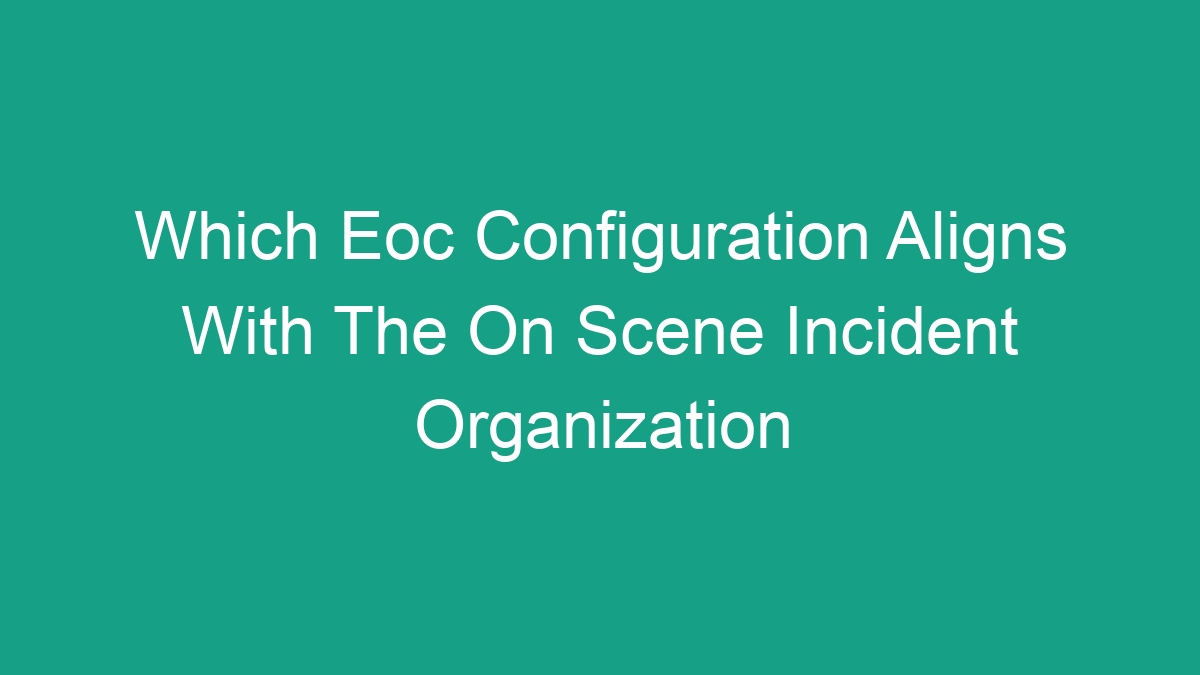
Understanding EOC Configuration
Emergency Operations Centers (EOCs) play a critical role in managing and coordinating response efforts during emergencies and disasters. The configuration of an EOC is essential for ensuring effective communication, coordination, and decision-making. One common question that arises is which EOC configuration aligns with the on-scene incident organization. In this article, we will delve into the different EOC configurations and how they align with on-scene incident organization.
Different EOC Configurations
There are mainly two types of EOC configurations – the Incident Command System (ICS) and the Emergency Support Function (ESF) model. Both configurations offer distinct approaches to organizing and managing response efforts.
Incident Command System (ICS)
The Incident Command System (ICS) is a standardized management system used to coordinate emergency response and provide a clear chain of command. It is typically utilized for on-scene incident management and is designed to be flexible and adaptable to different types of incidents. The ICS structure includes various roles and positions such as Incident Commander, Public Information Officer, Safety Officer, and Operations Section Chief.
Emergency Support Function (ESF) Model
The Emergency Support Function (ESF) model is a framework for organizing assets and resources in response to an incident. It is commonly used at the EOC level and involves the coordination of various functions such as transportation, communication, public works, and public health. Each ESF is led by a primary agency responsible for coordinating activities within that functional area.
Alignment with On-Scene Incident Organization
When considering which EOC configuration aligns with the on-scene incident organization, it is important to understand the distinct roles and responsibilities of each model.
Incident Command System (ICS) Alignment
ICS is specifically designed to align with on-scene incident organization. It provides a systematic approach to the command, control, and coordination of on-scene emergency response. The ICS structure mirrors the organization of the on-scene incident, allowing for seamless integration between the EOC and the incident site. This alignment ensures clear communication, unified command, and efficient resource management.
Emergency Support Function (ESF) Model Alignment
While the ESF model is primarily used at the EOC level to coordinate support functions, it also plays a crucial role in aligning with the on-scene incident organization. ESF coordinators work closely with incident management personnel to assess needs, allocate resources, and facilitate response efforts. The ESF model allows for the integration of EOC activities with on-scene operations, ensuring a coordinated and comprehensive approach to incident management.
Choosing the Appropriate EOC Configuration
The choice of EOC configuration largely depends on the nature and scale of the incident, as well as the specific needs of the response effort. In some cases, a combination of ICS and ESF models may be utilized to effectively manage both on-scene and EOC operations.
Considerations for ICS
When the incident requires direct on-scene management and coordination, the ICS configuration is the most appropriate choice. This is especially true for incidents such as wildfires, hazardous material spills, and search and rescue operations. The ICS structure allows for the establishment of a unified command and enables seamless collaboration between the incident site and the EOC.
Considerations for ESF Model
The ESF model is ideal for incidents that require extensive coordination of support functions and resources at the EOC level. This may include incidents such as hurricanes, pandemics, and large-scale power outages. The ESF model allows for the systematic organization of resources and facilitates collaboration between various agencies and organizations involved in the response effort.
Integration of EOC Configurations
In some situations, the integration of both ICS and ESF models is necessary to effectively manage complex incidents. This integration allows for a comprehensive approach to incident management, leveraging the strengths of each configuration to address the diverse needs of the response effort.
Unified Command Structure
By integrating ICS and ESF models, a unified command structure can be established to ensure seamless coordination between on-scene operations and EOC activities. This approach facilitates the sharing of information, resources, and decision-making processes, leading to a more efficient and effective response.
Collaborative Planning and Resource Allocation
Integrating EOC configurations allows for collaborative planning and resource allocation, ensuring that both on-scene and EOC needs are met. This approach fosters a unified response effort, minimizes duplication of efforts, and enhances the overall coordination of the incident management process.
Conclusion
In conclusion, the alignment of EOC configuration with on-scene incident organization is crucial for effective emergency response and management. Both the Incident Command System (ICS) and the Emergency Support Function (ESF) model offer distinct approaches to organizing and coordinating response efforts, with each configuration playing a vital role in different aspects of incident management. Understanding the specific needs of the incident and choosing the appropriate EOC configuration is essential for ensuring a coordinated, efficient, and successful response. Whether it’s ICS, ESF, or a combination of both, the key is to adapt the EOC configuration to the unique requirements of the incident to achieve the best possible outcome.



